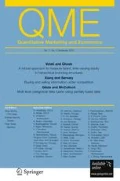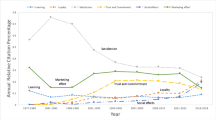Abstract
Bajari et al. (Quantitative Marketing and Economics, 14(4), 271–323, 2016) showed conditions under which the discount factor is identified in a finite horizon optimal stopping problem. We show that these conditions can be cast as a special case of a class of exclusion restrictions which are relevant for a broader scope of applications, and extend the identification result to both finite horizon and infinite horizon optimal stopping problems under more general exclusion restrictions. We also show how a similar approach gives identification of general discount functions in finite horizon optimal stopping problems. The identification results directly suggest estimators of the discount functions that are easy to compute.
Similar content being viewed by others
Notes
The discount factor is not restricted to the unit in finite horizon models for the model to be well-defined.
We omit the Euler’s constant as it is just a constant and does not affect any of our analysis.
We have adopted the term ‘exclusion restriction’ from Magnac and Thesmar for restrictions like Eq. 7.
References
Abbring, J., & Daljord, O. (2018). Identifying the discount factor in dynamic discrete choice models. Mimeo: University of Chicago.
Arcidiacono, P., & Miller, R.A. (2011). Conditional choice probability estimation of dynamic discrete choice models with unobserved heterogeneity. Econometrica, 79 (6), 1823–1867.
Arcidiacono, P., & Miller, R.A. (2018). Identifying dynamic discrete choice models off short panels. Cambridge: Working paper.
Bajari, P., Chu, C.S., Nekipelov, D., Park, M. (2016). Identification and semiparametric estimation of a finite horizon dynamic discrete choice model with a terminating action. Quantitative Marketing and Economics, 14(4), 271–323.
De Groote, O., & Verboven, F. (2019). Subsidies and myopia in technology adoption: Evidence from solar photovoltaic systems. Forthcoming american economic review.
Fang, H., & Wang, Y. (2015). Estimating dynamic discrete choice models with hyperbolic discounting, with an application to mammography decisions. International Economic Review, 56(2), 565–596.
Frederick, S., Loewenstein, G., O’Donoghue, T. (2002). Time discounting and time preference: A critical review. Journal of Economic Literature, 40(2), 351–401.
Hotz, V.J., & Miller, R.A. (1993). Conditional choice probabilities and the estimation of dynamic models. Review of Economic Studies, 60(3), 497–529.
Kalouptsidi, M., Scott, P.T., Souza-Rodrigues, E. (2018). Linear iv regression estimators for structural dynamic discrete choice models. Working paper: Harvard University.
Lee, R. (2013). Vertical integration and exclusivity in platform and two-sided markets. American Economic Review, 103(7), 2960–3000.
Magnac, T., & Thesmar, D. (2002). Identifying dynamic discrete choice processes. Econometrica, 70, 801–816.
Norets, A., & Takahashi, S. (2013). On the surjectivity of the mapping between utilities and choice probabilities. Quantitative Economics, 4, 149–155.
O’Donoghue, T., & Rabin, M. (1999). Doing it now or later. American Economic Review, 89(1), 103–124.
Phelps, E., & Pollak, R.A. (1968). On second-best national saving and game-equilibrium growth. Review of Economic Studies, 35(2), 185–199.
Rust, J. (1987). Optimal replacement of GMC bus engines: An empirical model of Harold Zurcher. Econometrica, 55, 999–1033.
Rust, J. (1994). Structural estimation of Markov decision processes. In Engle, R., & McFadden, D. (Eds.) Handbook of econometrics, (Vol. 4 pp. 3081–3143). Amsterdam: North-Holland.
Strotz, R.H. (1955). Myopia and inconsistency in dynamic utility maximization. Review of Economic Studies, 23(3), 165–180.
Acknowledgments
Park gratefully acknowledges the support provided by the National Research Foundation of Korea (NRF) Grant 2018S1A5A2A01029529.
Author information
Authors and Affiliations
Corresponding author
Additional information
Publisher’s note
Springer Nature remains neutral with regard to jurisdictional claims in published maps and institutional affiliations.
Rights and permissions
About this article
Cite this article
Daljord, Ø., Nekipelov, D. & Park, M. Comments on “identification and semiparametric estimation of a finite horizon dynamic discrete choice model with a terminating action”. Quant Mark Econ 17, 439–449 (2019). https://doi.org/10.1007/s11129-019-09210-w
Received:
Accepted:
Published:
Issue Date:
DOI: https://doi.org/10.1007/s11129-019-09210-w




